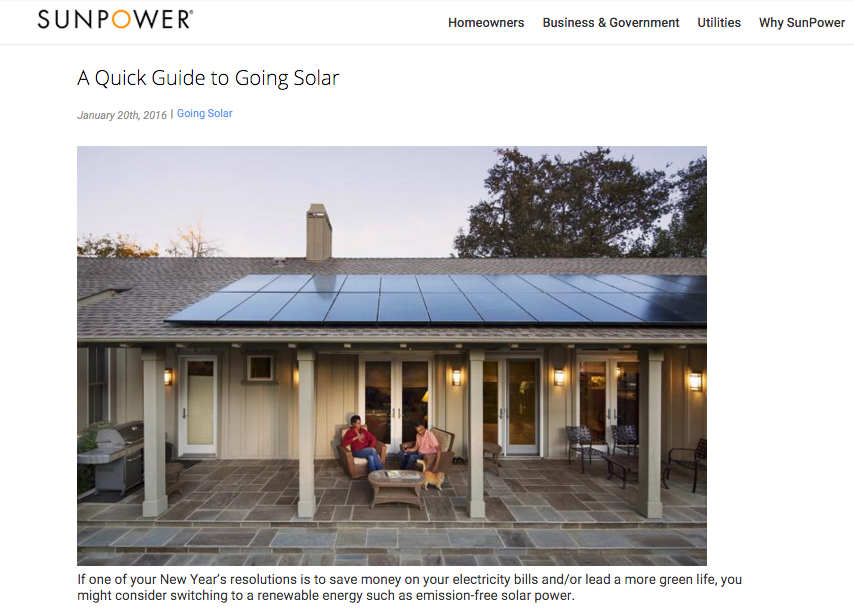
3 Ways Renewable Energy Brands Can Win With Content

 I’ve yet to see an example of an industry in which content marketing isn’t effective. After all, regardless of product or service, you’d be hard-pressed to find a prospective customer who doesn't love a good, entertaining and informative story. That being said, there are industries in which content marketing is more effective than others—industries with powerful messages poised to drive global change.
I’ve yet to see an example of an industry in which content marketing isn’t effective. After all, regardless of product or service, you’d be hard-pressed to find a prospective customer who doesn't love a good, entertaining and informative story. That being said, there are industries in which content marketing is more effective than others—industries with powerful messages poised to drive global change.
Renewable energy is one of those industries.
The reason for this is simple: The conversation about sustainable, renewable energy has never been as relevant, timely and important as it is right now. Environmental agencies and commercial and residential consumers are eager for solutions to the energy crisis, and poised to invest in the most feasible and pragmatic option. Alternative energy is no longer a futuristic ideal—it's a necessity. The winds of change have arrived. (See what I did there?)
In other words, so long as you have the right messages in the right place, targeting the right personas at the right time, your story will resonate.
Let’s take a look at the three ways your renewable energy company can succeed using content marketing.
Be Educational
Whether your key persona is a corporate procurement specialist or a private homeowner, consumers want to be as informed as possible before committing to an investment. In fact, it’s estimated consumers complete 70 to 90 percent of the buyer’s journey before even contacting a vendor. Before these prospects fill out a contact form or pick up the phone, they’re spending their time researching you, your competitors, costs, benefits, long-term value and more.
I don’t know about you, but I can’t even buy so much as a pair of socks without checking reviews and comparing my options. So you can only imagine the amount of time the average customer spends researching solar arrays.
The bottom line is: Your audience is hungry for knowledge—so give it to them! Break it down into snackable, easy-to-understand blog posts, in-depth white papers, entertaining videos, captivating videos, beautiful infographics and whatever other medium you see fit. But whatever you do, don’t use your content marketing as a platform for sales copy. Court your prospects, show them why they should trust you, be there in their time of need and then pop the question.
For example, SunPower, a California-based energy company that manufactures solar panels, published this guide to going solar. The company explains how solar energy works, how to determine cost, installation and offered a free solar calculator before ever asking prospects to contact them.

Share Your Unique Brand Story
Humans love stories. We crave them, seek them out and share them daily. A good book, movie or article makes us feel something. But do you know why? It’s all thanks to a hormone called oxytocin. (Bear with me—I’m about to get slightly scientific.)
Oxytocin is a chemical your brain releases to let you know you’re in a safe situation, such as when you hug someone you love. Recently, scientists discovered emotionally charged, character-driven stories also cause oxytocin synthesis. In other words, it’s possible to elicit an empathetic response from your customers simply by telling good stories.
By sharing your brand’s narrative, you can effectively win over the trust of your prospects. When a potential customer thinks of your brand, they’ll equate it with the warm, fuzzy feeling they experienced when learning your story.
Take, for example, this GE Renewable Energy video. It has all the makings of a great story: a hero, a twist ending and fun, whimsical cinematography. It’s relatable, memorable and elicits an emotional response.
Tap into the Human Drive for Good
So now you understand how stories make people feel, let’s talk about another way brand storytelling can benefit the alternative energy industry: by tapping into social conscience—empathy and the desire to help others.
What makes someone purchase a pair of Toms Shoes when there are less expensive renewables? Because the buyer enjoys the benefit of giving back to society. The Toms business model is proof people like doing good—even if it means a larger investment. What’s more, Toms tells its story through every action and every purchase.
As a renewable energy company, you’re already doing a lot of good—so make sure you’re sharing this within your brand narrative. Connect your product back with clear examples so prospects know, without a doubt, when they choose you they’re choosing the side of good.
An excellent example is this Ameresco video. The company not only walks you through how its product functions, but the actual people in the communities that are benefitting from the company’s solutions.
The fact is, renewable energy brands are ripe with content marketing opportunities. From educational articles and gripping tales to inspiring examples of social good, your company has all the storytelling fodder it needs to make a marked imprint in the content world.


